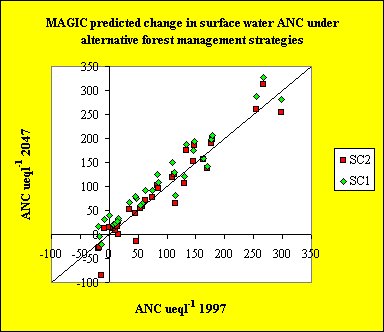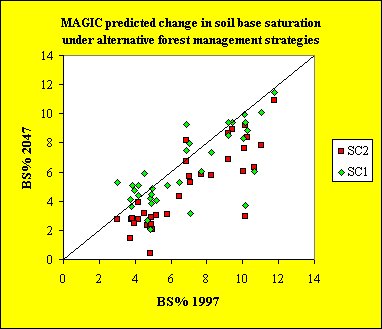

Thirty six of the sixty catchments in the region of Galloway are forested ranging from 10-100% forest cover. Two forestry scenarios were used in this regional application of MAGIC to assess future forest management strategies (Scenario 1 and scenario 2). These two land use scenarios combined with the agreed sulphur reductions (E10 deposition scenario) cause the response of soil and surface water quality to differ markedly from site to site. MAGIC predictions under the 'best case' forestry scenario (Scenario 1) indicate a small recovery in the surface water Acid Neutralising Capacity (ANC) compared to the ANC under the more realistic scenario which assumes forest rotation at 50 years i.e.planting a second rotation forest (Figure 1).
Figure 1

Under forest scenario 2, the predicted response within 50 years, relative to present day is generally a small recovery in surface water ANC. The spatial distribution of ANC in the region is shown on Figure 2. There is a distinct spatial pattern, with the more acidified, low ANC sites clustering at high atitude in an moorland area dominated by base poor granitic geology.
Despite the emission reductions, soil base saturation (BS) is predicted to acidify from 1997 to 2047 for the majority of catchments in the region (Figure 3). This implies that sulphur deposition is still greater than base cation supply from weathering. The future recovery of soils is complicated by changing land use at the forested sites. Clearly, a second rotation forest (SC2), with its base cation uptake requirements, exerts an additional stress on the soil base cation supply and so tends to exacerbate soil acidification in 2047.
Figure 3

The spatial distribution of soil base saturation in 1857, 1997 and 2047 is shown in Figure 4. The rapid loss of base cations from the soil between 1857 and 1997 results from increasing acid deposition which is known to deplete base cations from the exchange complex. The predicted impact of forestry (SC2) on base saturation in 2047 suggests further soil acidification (BS 0-3%) particularly at those sites with extensive forestry. Recovery of base saturation is suppressed by the demand on the base cation pool from tree uptake and enhanced deposition.